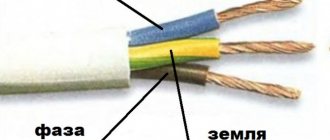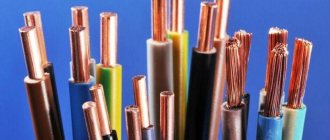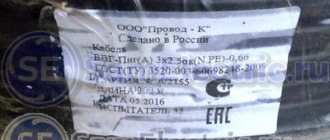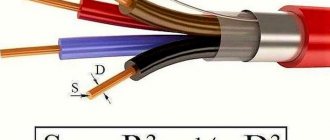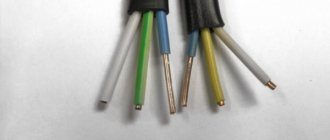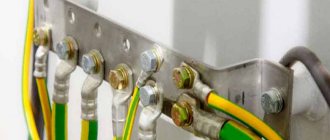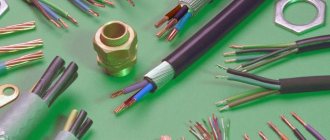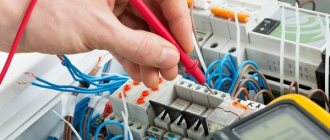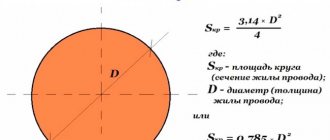In the power supply of any facility, from utility rooms, warehouses, to high-tech industries, it is impossible to do without electrical panels. The shield itself contains switching equipment and automation, as well as means for distributing and connecting consumers to the power supply network. In simple terms, the switchboard can be an input distribution device (IDU) or an automation and control panel. For normal operation of the system, it is necessary to use installation wires of appropriate quality in compliance with the conditions for their laying and installation. In this article we will tell you what kind of wire should be used to assemble an electrical panel (meaning brand, cross-section, etc.).
The composition of the electrical panel and its design
Composition of an electrical distribution panel in an apartment
The electrical panel is a metal box containing various switching and protective devices. They are connected using wires that have special requirements.
An input cable is inserted into the electrical panel through a special hole. After this, the electrical equipment is connected and the wires are laid inside the panel. The conductors must be connected according to the developed diagram.
A modern home panel includes the following switching and protective devices, as well as other types of products:
- Electricity meter.
- Automatic machines. They are installed at the entrance and to individual groups of energy consumers. Typically, an automatic switch is selected for the entrance, for the lighting group and for powerful electrical equipment in the apartment.
- RCD.
- Diffautomatic machines.
- Timer.
- Voltage and phase control relay.
- Other automation for control and monitoring.
The housing must be grounded, as well as metal doors and live parts. Otherwise, if there is a current leak, the shield will pose a potential danger to human life and health. The shield should be locked with a key to prevent access by unauthorized persons and to prevent electric shock.
Connecting circuit breakers (automatic machines)
In the article about connecting an electrical outlet, we looked at two options for molding the ends of the wires before inserting them into the terminals; we found out that this operation hides many nuances that significantly affect the quality and durability of the electrical wiring as a whole. In this article, we will look at a similar situation - we will compare the methods of connecting circuit breakers (automatic circuit breakers).
When assembling electrical distribution cabinets, it is often necessary to connect several circuit breakers to one conductor (usually an electric current source). There are several solutions to this problem:
- Use of a special splint (comb);
- The use of stranded (often called stranded) wires, crimped into sleeve lugs of the NShvI type;
- Connection with single-wire (single-core) wires.
Connecting busbar (comb).
Stranded wires in NShvI lugs are a universal way to connect automatic machines.
The first connection method is the simplest: we take a suitable busbar and install it in the cabinet. We will also skip the connection using the second method, using stranded wires, and will try to return to this issue later, in a separate article. Let us dwell in detail on the method that involves connecting with single-wire wires (jumpers).
This connection method has the following advantages:
- Low cost.
- As a rule, it is performed using single-wire wires of the main wiring of the room.
- Does not require the use of specialized tools (crimping pliers).
- Single-wire wire is preferable for a number of properties (greater corrosion resistance and overload capacity) for typical electrical wiring inside a building.
Wire selection
The requirements for cable products are determined by the conditions in which the product will operate. The shield is a device with limited space, so miniature and compactness are one of the main selection criteria. Reliability and durability are no less important for such products. The cable must bend well and withstand bending, so devices with an aluminum core are not suitable.
All conductors can be divided into classes based on flexibility. This indicator depends on the design of the cores. The higher the class, the more flexible the conductor. Monolithic conductors are difficult to bend and can break during operation, but they are easy to connect to the terminals. Stranded products bend better and are easier to work with, but the difficulty lies in the impossibility of connecting to terminals and screw clamps. To do this, you have to either tin the ends or crimp them with special tips. Otherwise, the contact will be unreliable and will not last long. The choice of stranded or solid wire also depends on the flexibility class of the product.
Types of wires PV-1
Based on all the characteristics given, you can select a number of wires that are suitable for inclusion. These include:
- PV-1. This is a product with a single-wire copper core, which has a single layer of PVC insulation. Flexibility class 1.
- PV-3. Stranded conductor with copper conductors, having PVC insulation with flexibility class 2 (for a cross-section from 0.5 sq. mm to 1.5 sq. mm), class 4 for a cross-section from 2.5 to 4 sq. mm. and class 3 flexibility for sections over 4 sq. mm.
- PV-4. Stranded copper cable with PVC insulation. It is a more flexible analogue of previous products. Flexibility class 4 and 5.
You can select foreign analogues of wires. These include H05VJ, H07VK, designed for voltages of 0.5 and 0.75 kV, respectively.
When choosing, you need to decide what cross-section of wire to use in the panel. This directly depends on the load in the room. It is recommended to use a connection wire with the same cross-section as the power cable. To connect the electric meter, cable products with a cross-section of 25 sq. mm are used. But another indicator must be taken into account - the maximum current strength for which the electric meter is designed. Depending on the brand, this is 50-60 Amperes, which corresponds to 10-12 kW. According to these criteria, a copper conductor with a cross-section of 10-16 sq. mm is suitable. or aluminum wire, whose cross-section will have to be increased to 16-25 sq. mm.
It is important to calculate in advance the cross-section of the wire for installation in electrical panels for connecting machines and the length. The calculations should be based on the input machine.
Which wire to use for outdoor wiring: the best options
We smoothly approached the main question of which wire to use for external wiring in order to be confident in its reliability and ability to withstand negative natural influences. The main requirements for such products are combustion resistance, strength and non-hygroscopicity.
The most popular types include:
SIP is an outdoor power cable capable of conducting voltages up to 1000 V. Structurally, the product is a group of wires with individual insulation and aluminum conductors. Such products have their own subtypes (SIP -1, 2, 3, and so on) and are produced in many countries around the world. The main feature is the black insulation of the wires. The use of such a cable guarantees greater reliability during aerial installation and reduces installation costs. An additional advantage is its compactness, which allows the cable to be used even in conditions of limited space.
AVBbShv is a product based on a group of wires with aluminum cores combined under one armored sheath. One of the cable types is VBBShV - a version with copper wires. A special feature is the possibility of laying in the ground without the use of additional protection and resistance to mechanical stress. Main characteristics:
- The presence of steel tape in the shell.
- The wire insulation is made in different colors for ease of dialing and connection.
- The outer shell is black.
- Resistant to moisture and temperature changes.
- Resource - 30 years.
Due to the presence of armor, cable products of this type are characterized by increased rigidity, which creates additional problems during the installation process.
NYY is a cable characterized by versatility and reliability in operation. May have copper or aluminum conductors. This product is increasingly used for external wiring in the ground or in the air, as well as for connecting electrical receivers indoors. Main characteristics:
- Resistant to water and fire.
- Compliance with international standards.
- Availability of multi-colored wire insulation.
- Convenience of organizing outdoor wiring.
- The outer shell is black PVC plastic.
- Resistant to temperature changes.
- Resource - 30 years.
This cable is produced in many factories due to its versatility and reliability. The main competitor of the product is considered to be the VBBShV cable, which was mentioned above.
NYM is a reliable cable that is actively used in production and outdoor wiring. Its peculiarity lies in its versatility and ability to operate in various conditions. Characteristics:
- Compliance with the standards of the German Electrical Engineers Union.
- Heat resistance and ability to operate over a wide temperature range.
- Non-hygroscopic and durable, which allows the product to be laid in concrete or in a layer of plaster.
- The cross-section is round, the color is gray.
- Fire resistance.
When installing wiring outdoors using NYM, protection from sunlight is recommended. Such cable products are produced at many factories located in Europe and Russia. Some manufacturers produce cables according to individual specifications, but such products have a lower price and, accordingly, worse quality. The use of such cables for external wiring is not recommended.
Required Tools
To reliably make a connection in the panel, you need to purchase special tools in advance. They must be professional and have insulated handles. Required tools include:
- Hammer.
- Bulgarian.
- Screwdrivers, including an indicator screwdriver for checking the absence of voltage on the wires.
- Knife.
- Device for stripping insulation.
- Pliers.
- Wire cutters.
- Portable lamp.
After preparing the tool, you can begin installation.
Installation and connection
Before starting work, it is necessary to de-energize the room. Using a tester, it is checked whether voltage remains on the conductors. Using the probes of a screwdriver, you need to touch each core one by one. If the light does not light up, you can start working. It is prohibited to work with electricity turned on. It is also important to prepare tools in advance and provide the master with an autonomous light source.
When connecting wires in a panel, it is important to remember that the colors of the wires indicate their purpose. The core can be completely painted in one color or another or have a color mark at the entrance to the device, that is, at the ends of the conductor. The following scale is used:
- Phase – gray, black.
- Zero is blue.
- Grounding – yellow-green.
The wire for installing the electrical panel must be laid in such a way that there are no sagging or unnecessary bends. To do this, the length of each segment is determined in advance with a small allowance of 2-3 cm.
All connections to the machine are made using jumpers. Single-wire rigid wire can be used for this purpose. If possible, it is better not to use jumpers, but to do everything through the connecting core. Thanks to it, the contact will be reliable and the appearance will be aesthetic.
It is not recommended to connect more than two wires to one terminal. If this cannot be avoided, the cables must have the same cross-section.
Preparation of jumpers and connection diagram
Conductors need to be prepared for connection in the panel. To do this, you need to strip the ends from the insulation using a knife or a special tool. The cores should be inserted into contact and tightened well with a screwdriver.
During operation, you need to pay attention to the following:
- The insulation should not get caught in the clamp.
- The exposed part of the wire should not stick out from the contact over a large area. This requirement is made by network organizations that seal meters. This helps prevent illegal connections from outsiders.
- The upper screw is tightened first, followed by the lower one.
The last step is to check the reliability of the fixation. The veins need to be carefully touched and pulled apart. The conductor should not swing or stagger.
Connection of machines
Next you need to connect the neutral wire. It is connected using a jumper from the lower right contact of the automatic two-pole switch to the third contact of the electric meter. The ends also need to be stripped of insulation, connected and tightened with screws. The wires must not touch each other. Be sure to leave a gap between them.
Now you need to connect the outgoing wires from the meter. First, the phase is connected through a jumper to the upper contact of the machine. The ends are stripped and joined. The phase also needs to be distributed among other sources in the directions of the machines.
There should be one contact left from the electricity meter in the apartment. This is the outgoing zero contact, which must connect to the zero bus. Usually it comes complete with a plastic box. Length, dimensions and configuration vary by manufacturer.
Basic rules for laying wires
All of the above actions must be performed in accordance with the rules adopted by the PUE. Failure to comply may result in negative consequences, including electric shock and possible short circuit.
Primary requirements:
- The input panel, distribution boxes, and meter must be mounted in easily accessible places.
- The wires should not intersect; there must be a distance between them.
- The cross-section of the wire in the panel for connecting automatic devices, RCDs and other products is selected depending on their current load.
- A conductor layout plan should be created.
- Wires should not touch metal parts and building elements.
- All connections in the junction box must be securely insulated.
- Protective and neutral wires are attached to the devices using a bolted connection.
While working, be sure to follow safety precautions. The technician must wear protective dielectric gloves and goggles.
General principles for wiring in the panel
The switchboard contains all the equipment and mechanisms for connecting consumers to electricity. For its proper operation and safety, it is important to use suitable wires and high-quality parts, because due to a malfunction, users may be left without light, or a fire may even start. The function of conductors in an electrical panel is to connect controllers, indicators and other devices. The entire panel, including the metal casing, must be reliably grounded. Ideally, you should also put a lock on it so that unauthorized people do not have access to the equipment.
The connection must be made in such a way that the connecting wires do not sag. To do this, you need to carefully measure the distance between the connection elements and cut off a few centimeters more so that they can be inserted into the terminals. You cannot save on this, and if the calculations turn out to be incorrect, it is better to repeat the operation.
